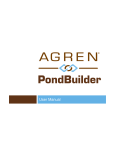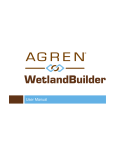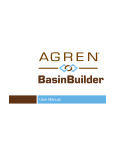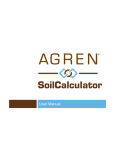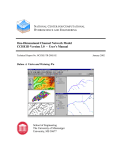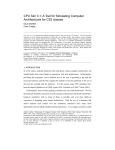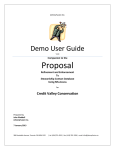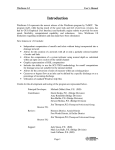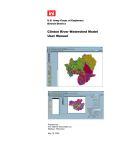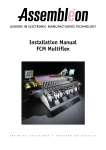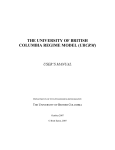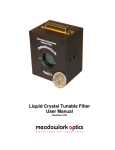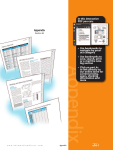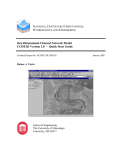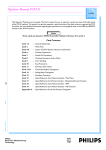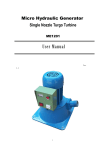Download WaterwayBuilder
Transcript
WaterwayBuilder User Manual AGREN® WaterwayBuilder Agren Disclaimer The content and products associated with Agren’s WaterwayBuilder are provided to you on an “asis” and “as available” basis. Agren makes no representations or warranties of any kind, expressed or implied, as to the operation of WaterwayBuilder or the information, estimates, content, materials, products or services included on or associated with WaterwayBuilder. You expressly agree that your use of WaterwayBuilder and all products and services included on or associated with WaterwayBuilder are at your sole risk. Agren does not make any representations, warranties, or guarantees, expressed or implied, regarding the accuracy, correctness, or completeness of the content of WaterwayBuilder, nor the safety, reliability, title, timeliness, completeness, merchantability, conformity, or fitness for a particular purpose of the content of WaterwayBuilder. It is your sole responsibility to independently evaluate the accuracy, correctness, or completeness of the content of WaterwayBuilder. Agren makes no representation, warranty, or guarantees that the content is free of infection from any viruses, worms, or other code or computer programming routines that are intended to damage or detrimentally interfere with any system data. WaterwayBuilder Introduction WaterwayBuilder will step you through the simple process of drawing a waterway centerline, splitting the waterway into multiple reaches, adjusting the elevation of the reach ends, and changing the slope of each reach. You will have the option of entering your own runoff curve number or calculating the runoff curve number in WaterwayBuilder. After computing waterway width and depth, WaterwayBuilder will plot cross sections and estimate the cubic yards of earthwork necessary. Waterway plans can be done using the newly developed Effective Stress Approach (Tractive Stress Method) or the more traditional Permissible/Allowable Velocity Design Approach. Page 1 AGREN® WaterwayBuilder Initial Subscriber Login When your account is created by Agren, the subscriber for your account will receive an activation email containing an activation link. The activation link is valid for 30 days. If 30 days has elapsed and the link has not been used, you will need to contact [email protected] to have a new activation link sent. When the subscriber clicks the activation link, they will be prompted to choose a password (see following pages for password requirements). Enter and confirm your chosen password and click Activate My Account. You will be redirected to the login screen, where you will need to log in again with your username (typically your email address) and password. Executing the End User License Agreement (EULA) As the Subscriber, you must execute the End User License Agreement (EULA) before accessing any part of the tools. Click on Click here to execute the EULA. Read the EULA and if you agree with the terms, click I Agree to execute the EULA. The current copy of the EULA can always be found by clicking EULA in the footer of the login system. Managing M y Users Part of the responsibility of the subscriber is to manage the users assigned to their license. Initially, this requires setting up users that can access your license. Upon executing the EULA, the subscriber will be redirected to the Manage My Users page. The Manage My Users page contains three sections, Add New User, Search & Add Existing User, and Edit Licensed Users. To add a new user, type in the user’s first name, last name, email and company/agency under the grey bar Add New User. The user name will automatically populate when you enter the email address. Clicking Add New User will add the user to the license you are logged in to and email them an activation link. (If the user needs to be added to another license you are the subscriber for, you must log into that license and repeat the steps.) If you would like to add a user that is an existing user on another license, you may enter their user name (typically their email address) under the grey bar Search & Add Existing User. Clicking Add Existing User will add the user to the license you are logged in to. It is the responsibility of the subscriber to keep their license information current as employees are hired or terminated. To remove a user from a license, click Remove From License to the right of the user’s name under the grey bar Edit Licensed User. To edit first name, last name, or company, click on the user’s name in the first column of the Edit Licensed User table. If you need to change a user’s email address or user name, contact Page 2 AGREN® WaterwayBuilder [email protected]. If a user’s activation link has expired, you can also send another activation link by clicking Resend activation email from the Manage Individual User page. A link to Manage My Users can be found in the footer of the login screens. Initial User Login When your subscriber accepts the EULA and sets up the users for a license, activation emails will be sent to each user. The email contains an activation link that is valid for 30 days. If 30 days has elapsed and the link has not been used, you will need to contact your subscriber to have a new activation link sent. When you click on the activation link, you will be prompted to choose a new password (see below for password requirements). Enter and confirm your chosen password and click Activate My Account. You will be redirected to the login screen, where you will need to login again with your username (typically your email address) and password. For subsequent logins, go to www.agrentools.com. Click on LICENSED USER LOGON in the top right corner of your screen. Password Requirements Passwords must be at least 12 characters in length and may only be repeated once every 24 passwords. In addition, passwords must contain characters from three of the following four categories. • • • • English uppercase characters (A - Z) English lowercase characters (a - z) Base 10 digits (0 - 9) Non-alphabetic characters (e.g., !, $, #, %) Passwords must be changed every 180 days. Seven days before the expiration of your password, you will receive an email notifying you that your password will expire and provide you with instructions on how to change your password. On the day your password expires, you will receive an email notice that your password has expired with a link to the initial login screen to reset your password. Resetting Your Password After three incorrect login attempts, your account will be locked for 15 minutes. After 15 minutes, you may retry your account, or reset your password. To reset your password, click Forgot your password? on the login screen. A Forgot Password screen will come up. Enter your user name (typically your email) and click Submit to send an email with a link to reset your password. Page 3 AGREN® WaterwayBuilder When you click the link in the password reset email, you will be redirected to a Reset Password screen. Choose a new password following the requirements above, and confirm. Once your password is updated, you will be prompted to log in again with your user name and new password. Managing M y Info To edit your first name, last name, or company, click on your user name (typically your email address) and then click Manage My Info in the footer of the login screens. If you need to change your email address or user name, contact [email protected]. Choosing a License and Tool From the login screen, choose the license you want to access from the drop down list. To access Agren’s conservation planning tools, click on the tool you would like to use below the license selection. Customer Support The footer of every login screen contains a link to customer support. If you experience even the smallest problem while using Agren’s conservation planning tools, please let us know! We do our best to get you answers within the hour, 8am to 5pm CST Monday through Friday. There are three ways to contact Agren customer support: 1. Click Find a Bug? when using the tools The Find a Bug? icon (just to the left of Enable Help on the top of your map) records information about your session, as well as a screen shot, and pops up a window where you can type your question or report a bug. This is the best way to report bugs or ask questions because we receive the most information to help diagnose your problem. Please be as descriptive as possible in explaining the problem you are experiencing. Occasionally, we might also ask for a copy of the session you are working on. 2. Email [email protected] Please be as descriptive as possible in explaining the problem you are experiencing. 3. Call (712) 792-6248 Page 4 AGREN® WaterwayBuilder Enabling and Disabling Help WaterwayBuilder is equipped with a help menu that steps you through the process of creating a waterway. To enable help, click on the box to the left of Enable Help on the blue bar at the top of the page. When this box is checked, Enable Help will be turned on. A check mark in the box indicates that the help is on. To move through the step-by-step process, simply click Next >> in the help window to advance to the next help screen. At any time, you may temporarily close the help window by clicking the “X” in the top right corner of the help window. When you click on another icon, the help menu will reappear. Click on Next>> in the help window to advance to the next help screen. To disable the help menu, uncheck Enable Help in the blue bar on the top of your screen or click Disable Help in the bottom right of the help window. Page 5 AGREN® WaterwayBuilder Zooming to Waterway Location The location of the proposed waterway is the first information that is requested. Zoom in far enough that you can easily distinguish the contour lines, but still see the entire waterway watershed on the screen. There are two methods to zoom to the desired waterway location. Method A Enter a legal description (section, township, and range) and click Search. If the box shown at the left does not appear upon program startup, click Zoom to Legal Description in the upper right hand corner of your screen. Click on the Imagery box in the bottom left corner of the screen to turn on the aerial photo map layer. Once you have zoomed to the appropriate section, you may zoom in further one of five ways. 1. Click and hold the left mouse button on one corner of the area of interest. Drag the pointer to the opposite corner drawing a rectangle and release. 2. Using the scroll bar/wheel on the mouse, roll forward to zoom in, roll backward to zoom out. 3. You may also click on Zoom In or Zoom Out in the map tools to the left of the map and then click once on the area of interest on the map. This way is not recommended because there is no control over the zoom. Frequently this command zooms in too far. 4. Click the + or – in the top left corner of the map to zoom in and out. 5. Press the + or – on the key board of your computer. If the legal description is known, the Zoom to Legal Description box easily zooms you into the correct location If the Imagery box is in grayed out, you have not zoomed in far enough to use Imagery yet. Zoom in until the Imagery box turns black. (This applies to the Contours and Terrain buttons as well.) Method B Click on Pan (located to the right of the Zoom In and Zoom Out tools). Then, click and drag the map to the desired location and zoom in or out with one of the five methods described above. Page 6 AGREN® WaterwayBuilder Map Layer Options In the bottom left hand corner of your screen, you will find check boxes that allow different viewing options (shown on the right). Check the box next to the map layer(s) you prefer to work with when planning your waterway. Imagery provides you with an aerial photo of the area selected. The Imagery layer is available in areas less than 25 miles wide. Contours inserts two-foot contour lines. The Contour layer is available in areas less than two miles wide. Map Layer Options Terrain inserts hill shading. The Terrain layer is available in areas less than two miles wide. You may use any combination of imagery, contours, and terrain layers at the same time. However, if you have imagery and terrain layers on at the same time you will only see the terrain layer. Waterway Tools On the left of your screen, below Map Tools, you will find Waterway Tools. The waterway tools allow you to draw your primary waterway, move your outlet, view a cross section of the waterway, and use the profile view to split the waterway into multiple reaches. Once the waterway is split into reaches, you can click Show Stations to view the length of each reach. The tools will be described in detail on the following pages. Waterway Tools Page 7 AGREN® WaterwayBuilder Drawing the Primary Waterway Determine where you want to place the primary waterway and select the Draw Primary tool. Click on the map where you want your waterway to begin. Always begin to draw the waterway from the outlet. Continue clicking points on the map to draw the waterway centerline. Double click on the last point to complete the centerline. The beginning of the waterway, or Station 0+00, will always be at the upper end of the waterway. Always begin to draw a waterway from the outlet. The beginning of the waterway, or Station 0+00, will always be at the upper end of the waterway. To change the location of the waterway centerline, click the Redraw Primary tool (originally the Draw Primary tool). The original waterway centerline will remain visible, enabling you to trace portions of the original drawing, until you double click to end the new waterway. Alternately, you can click the Clear Primary tool to completely delete the primary waterway. Then, use the Draw Primary tool again to draw a new centerline. Labeling the Waterway After double clicking to end the waterway, a popup box will appear that will allow you to label the waterway. You can assign any letter, A-Z, to the primary waterway. Waterway reaches will later be automatically named with the letter of primary waterway and a corresponding reach number; for example A-1, A-2, A-3. Note: The popup box can sometimes take between 30 and 45 seconds to appear. Moving the Outlet To move the outlet upstream from the current location, click on the Move Outlet tool. Place your pointer on the desired location of the new outlet and click on the line. Click the Reset Outlet tool (originally the Move Outlet tool) to move the outlet back to the original location. The new outlet will be depicted by a blue circle at the end of the waterway centerline. The outlet tools will become inactive as you continue to plan the waterway. Page 8 AGREN® WaterwayBuilder Cross Section View The Cross Section View allows you to view cross-sections of the waterway in 25, 50, or 100 foot intervals. Click <Previous or Next> to navigate through the cross section intervals. To change the interval setting, click the Station Interval drop down arrow and choose the interval you want to view the cross-sections in. You can skip to any interval by clicking the Go to Station drop down arrow. Page 9 AGREN® WaterwayBuilder Profile View The Profile View is used to divide the waterway into reaches. The length of the waterway (in feet) is displayed on the X axis. Elevation (in feet) is displayed on the Y axis. A solid black line depicts natural ground and a blue line depicts the proposed waterway. The slope of each reach segment of the proposed waterway is provided below the X axis. In the example shown, the slope of the proposed waterway is 0.48%. If you have a dual or large monitor, you can drag the Profile View off the map, allowing you to see both views at the same time. Your pointer will mark the same location in both the Profile View and the Aerial View (map). Page 10 AGREN® WaterwayBuilder Splitting a Waterway into Reaches Click Split Reach from the Profile View. Next, place your cursor on the blue Proposed WW Flowline and drag that point up or down to change the elevation of the reach end. To change the location of the reach end, release and re-click the point and drag left or right. You can split the waterway into as many reaches as you desire. The slope of each reach is given below the X Axis (2.99%, 0.56%, and 0.21%). Additionally, you can fine tune the location and elevation of the reach end by nudging it up and down and right and left. Click the + or – once to move the station location five feet to the right or left. Or, click of + or – to adjust the cut/fill and elevation 1/10th foot up or down. When nudging, the exact location of the reach end is shown in the Station and Cut/Fill boxes. When finished, click Exit Splitting (originally Split Reach) and then Save. If you exit without saving your work, all changes will be lost. To delete a reach, click Exit Splitting and then click Delete Reach. Next, click on the Reach End you want to remove. Click Save when finished. Page 11 AGREN® WaterwayBuilder Drawing your Watershed It is easiest to show the entire watershed in the viewing frame before you begin to draw the watershed. While drawing the watershed, you can use the + or – in the view, arrow keys on your keyboard, or the scroll bar on your mouse to zoom. While drawing the watershed, the Zoom In and Zoom Out map tools are disabled. Click Draw Watershed. The watershed will automatically attach to the outlet of the waterway. As you follow the watershed boundary, click each time you change direction. Double click before returning to the outlet of the waterway to complete the watershed boundary. To draw subwatersheds, click Draw Subwatersheds. The watershed will automatically connect to the first reach end upstream from the outlet. Repeat the process for all subwatersheds. Turn on the Contours map layer before you draw your watershed boundary. If you make a mistake, click on Clear Watershed, Clear Subwatersheds, or Clear Flowlines to erase the drawing. You may also right click on a single point to remove it. Drawing Flowlines A flowline is the distance that water travels as a raindrop from the point of impact to the downstream end of a waterway reach. Flowlines are used to determine the longest flow path of water, or the greatest distance that water flows, from the top of the watershed, to the downstream end of the reach. In WaterwayBuilder, only one flowline can be drawn for each watershed/subwatershed. Click on the Draw Flowlines tool. Initially, the flowline will be attached to the outlet of the primary waterway. Continue to draw along the flow path until you reach the edge of the watershed. After doubleclicking to end the flowline, the next flowline will attach to the reach immediately upstream from the primary waterway outlet. Page 12 AGREN® WaterwayBuilder Entering the Runoff Curve Number (RCN) WaterwayBuilder can calculate a runoff curve number automatically, or you may enter it manually. Click on RCN and follow the prompts. If you already know your runoff curve number, you may enter it at the prompt and then skip to Create Waterway. To allow WaterwayBuilder to calculate your runoff curve number, follow the instructions below to assign hydrologic soil groups, cut land use, and assign land cover. The Runoff Curve Number Help Box allows you to skip ahead if you already know your RCN value. Assigning Soil Hydrologic Groups To speed up processing, you can turn off the contour and terrain layers. You will need only the imagery layer during the remaining steps. Soil polygons can be assigned dual hydrologic groups. Soil polygons that are white on the map are assigned dual hydrologic groups (A/D, B/D, or C/D). The first letter in a dual hydrologic group represents drained areas and the second letter represents undrained areas. Only the soils that in their natural condition are in group D are assigned to dual classes. Existing water bodies at the time of soil hydrologic group assignment could have letters A, B, C, or D. The choice of which of these four letters is used is up to the user. Left click to assign soil hydrologic groups to all white polygons. If your Left click on each of these polygons and choose the hydrologic group that best represents that polygon. In the watershed does not contain any white case of existing basins, you will have a choice of all four areas, you may skip this step. letters. Choose the letter that best represents the waterway. All the white polygons within the watershed must be assigned a letter before a runoff curve number can be calculated. Page 13 AGREN® WaterwayBuilder Cutting and Assigning Land Covers Differentiate land cover types in the watershed by clicking the Cut Land Covers tool. Cut up the watershed until all of the cover types are separated. Cut up the watershed by drawing a polygon around each different cover. First, click on the outside of your watershed polygon. As you follow the edge of your cover type, click every time you change direction and end by double clicking after you have crossed a line. To draw a polygon around a cover type in the center of the watershed, click on the start point and follow the edge of the cover type. When you get back to the beginning, cross your beginning point and double click to end the polygon. If you have not intersected another line both at the beginning and at the end of your drawing, the polygon will not be developed. You may intersect the watershed boundary, another cover type, or the current cover type on which you are working. Click on the Assign Land Cover Desc. tool. Each region in your watershed must be assigned a cover description (cover type – treatment and hydrologic condition). To assign a cover type, hold the mouse arrow over a polygon. Left click once on the polygon and a menu of descriptions will be displayed. Next, select the most appropriate cover type for that polygon. Continue this process until all polygons are labeled. WaterwayBuilder will not allow you to move to the next step until you have assigned at least 95% of the watershed a cover type. A variety of cover types are available for Cultivated Agricultural Lands, NonCultivated Agricultural Lands, as well as Urban Areas. Page 14 AGREN® WaterwayBuilder Create Waterway You are now ready to create your waterway. Click on the Create Waterway tool and the Review Waterway dialog box will appear. For each waterway reach, the table will display the slope of reach, watershed acres, RCN, maximum flow length, average slope of the watershed, storm frequency, and the design discharge (CFS). You can change any of these values, with the exception of the design discharge (CFS). CFS will change as you change the other values and click Update. You may enter your own values in the Waterway Review window or proceed with calculated values. For example, to change the storm frequency, click the Storm Frequency dropdown menu for the specific Waterway Reach and choose a different Storm Frequency. Click Update to save the change and recalculate the Design Discharge (CFS). Make changes to the Review Waterway dialog box with caution. There is no validation on changes made to values in this table. You are now ready to start the Waterway Design process, click Start the Waterway Wizard. Using the Waterway Wizard The Waterway Wizard will lead you through several simple steps to compute the width and depth of your waterway. In the first screen of the wizard, you will select a waterway channel shape. Select either Parabolic, Trapezoidal, or Triangular and then click Next> to continue with the wizard. Each shape will require different input information from the user. Answer each question in the wizard and click Next> to advance to the next screen. After you have completed inputs for waterway shape, you will need to complete the Vegetation Parameter You may choose parabolic, trapezoidal, information. Select Retardance Class Method, Stem or triangular as the shape of the Length and Density Method, or Retardance Curve waterway channel. Index Method. In most cases, the “Retardance Class Method” will be used. Each methodology will require different input information from the user. Answer each question in the wizard and click Next> to advance to the next screen. Page 15 AGREN® WaterwayBuilder Next, you will choose the method you will use to define the soil parameters. First, decide how far out from the centerline you want to consider soils information. The default is a width of 15 feet on each side of the centerline. You can override this value by typing in your preferred width. Next, select either Automated Method (Soil Parameter Method) or Manual Method (Stress Parameter Method) to define soil parameters. In most cases, the “Automated Method (Soil Parameter Method)” will be used. Each methodology will require different input information from the user. Answer each question in the wizard and click Next> to advance to the next screen. If the Automated method is selected, WaterwayBuilder determines all the soil types within the designated width (15 feet default) on each side of the centerline. Each soil is automatically categorized, based on NRCS recommendations, into four different groups: Easily Eroded, Erodible, Erosion Resistant, and Very Erosion Resistant. A table is generated to show results of this classification. WaterwayBuilder will select and highlight in red the cell that has the greatest percent of soils that are classified as Erodible or Easily Eroded. In the example below, 13% of the soils in Reach A1 (greater than 5% minimum) of the soils are Easily Eroded. Therefore, Easily Eroded is the classification used for calculations for Reach A1. In Reach A2 (and similarly in Reach A3), none of the soils are Easily Erodible, but greater than 5% are Erodible. Therefore, Erodible is automatically selected and highlighted in red. You are able to change the erodibility category of any reach. Click on the cell under the category you want to select for each reach. The new selection will be colored red; the cell of the previous selection will return to white. Click Next> to advance to viewing waterway width and depth results. Page 16 AGREN® WaterwayBuilder Viewing and Modifying Waterway Width and Depth Based on the Effective Stress Approach (Tractive Stress Method), a “Best Fit” width and depth is calculated for each reach. This Best Fit design is always shown in the left most columns under the “Best Fit Design” header. To change the width or depth, type the desired parameter into the appropriate column under “Proposed Design”. You will only be allowed to input either a depth or a width, you cannot change both parameters. In the example below, the waterway depth was changed from 1.2 feet to 1.5 feet. WaterwayBuilder will not provide a design for waterways less than 1.0 foot deep and 30.0 feet wide. If smaller values are entered as the proposed design, WaterwayBuilder automatically rounds up to the minimum design parameters. WaterwayBuilder will not provide a design for waterways greater than 3.0 feet deep and 200.0 feet wide. A warning will appear in red if the maximum design parameters are exceeded. You cannot move on until the values are corrected. After changing the Width or Depth, you can return to the Best Fit design by clicking Refresh for the appropriate reach. When you are satisfied with the waterway design, click Finish and the window will close. To return to this window, you must click Create Waterway in the main toolbar and work through the entire wizard. Page 17 AGREN® WaterwayBuilder Viewing Designed Waterway After the design is complete, you can again view the proposed waterway in the Cross Section View and/or the profile view. Clicking Cross Section View on the main toolbar allows you to view the proposed waterway imbedded in the natural landscape. The red line indicates the shape and location of the waterway design. You can view cross-sections at 25, 50, or 100 foot intervals. If you are not pleased with the design of the waterway and how it fits in the natural landscape, you can modify the waterway by clicking Profile View on the main toolbar. From this view, you can move the reach ends up or down in elevation, move the reach breaks upstream or downstream, and add or delete reach breaks. Click Cut/Fill Volume to see the total cubic yards of cut/fill for every 100 foot section of the waterway. The bars above the line are cuts. The bars below the line are fills. If any modifications are done to the waterway design, click Cut/Fill Volume again to see the revised amounts. Page 18 AGREN® WaterwayBuilder Modifying Results There are multiple ways to modify your waterway design. Depending on the complexity of the design, you may have to go through this iterative process more than once. Moving reach breaks up or down in elevation: After changing the elevation of the reach breaks, click Save in the profile view. By moving the elevation of the reach break, you do not affect the watersheds. Therefore, you do not have to redraw the watersheds and go back through the design process since these changes do not affect the subwatersheds. Instead, shortcut the design process by clicking Waterway Results. This will take you to the Waterway Results Table where the “Best Fit” will be recalculated for the new slope of the reach. Moving reach ends upstream or downstream: If you move the reach ends upstream or downstream, the watershed and subwatersheds will no longer be accurate. WaterwayBuilder will automatically delete the outline of the watershed and subwatershed when you click Save in the profile view. For these modifications, click Create Waterway and go back through the design process redrawing the watershed and subwatersheds. Inserting a new reach: To insert a new reach, refer to the section Splitting a Waterway into Reaches. Click Save in the profile view when finished. When moving reach ends, or inserting or deleting reaches, you will need to go back through the “Create Waterway” and “Waterway Wizard” processes to recalculate waterway depth and width based on changes to drainage, time of concentration (TOC), and reach slope. If a new reach is installed, all of the subwatersheds and the flow lines will be deleted and will need to be redrawn. Deleting a reach: To delete a reach, refer to the section Splitting a Waterway into Reaches. Click Save in the profile view when finished. If a reach is deleted, all of the subwatersheds and the flow lines will be deleted and need to be redrawn. Page 19 AGREN® WaterwayBuilder Printing and Saving Reports Several versions of reports are available to print and/or save. There are separate reports for both the landowner and the planner. The Planner’s Report offers more comprehensive information than the Landowner’s Report. To create a report, first zoom to the desired map view and turn on/off map layers that you want to appear in the report maps. The image you see on the screen will be the image printed in all the reports. To create a report, click on the Create Report button. Enter data into the Create Report dialog box. Then, check the boxes of the reports you want to save and/or print and click on Create Report! at the bottom of the dialog box. Choose whether you would like to open or save the file. (If the report is opened, it may still be saved after the report has been opened or printed.) An Adobe Acrobat (PDF) report will be created. If both the Landowner’s Report and the Planner’s Report are selected, they will appear in one continuous PDF File. To print only one report, you will need to choose File, Print and indicate the page numbers you would like to print. The estimated cost of earthwork can be calculated by either Cubic Yard of Cuts or simply by Linear Feet. The Landowner’s Report will include: • • • • • Disclaimer statements Aerial view of waterway layout Waterway depths, lengths, widths, and acreage Estimated costs, including earthwork and seeding Operation and maintenance requirements Saving a report is the best way to document what was provided to the landowner. The Conservation Planner’s Report includes all of the above and: • • • • Detailed specs for earthwork, including costs Watershed information including drainage areas, RCN, time of concentration, average watershed slope, and design discharge Waterway profile views Waterway cross section views at 25, 50, or 100 feet intervals Page 20 AGREN® WaterwayBuilder Saving and Loading a Session To save a session so you can return to it at a future point in time, choose the Save Session tool under Session Management menu option on the left hand side of the screen. Give the file a descriptive name and choose a location to save it. The session will be saved as a .wwy file. All information will be saved unlike PondBuilder, BasinBuilder and WetlandBuilder. To load a previous session, simply choose the Load Session tool under Session Management menu option on the left hand side of the screen and navigate to the .wwy file you would like to load. Saving and Loading a session Loading a previous session allows you access to other waterways from the Waterway Selection table and allows you to alter values from the previous waterway. Using the GIS Data Function The GIS Data function allows information to be saved as an ArcGIS layer and a Microsoft Access file. To save the GIS Data, click the GIS Data function under Waterway Generation from the menu options on the left hand side of the screen. A zip file containing an ArcGIS layer file (.lyr) and a personal geodatabase file (.mdb) will be saved. The layer file and the personal geodatabase file can be added directly into ArcGIS. From ArcGIS, these layers can be downloaded an AutoCAD program or a GPS unit. Get GIS Data Page 21 AGREN® WaterwayBuilder Notes:_______________________________________________________________________ ____________________________________________________________________________ ____________________________________________________________________________ ____________________________________________________________________________ ____________________________________________________________________________ ____________________________________________________________________________ ____________________________________________________________________________ ____________________________________________________________________________ ____________________________________________________________________________ ____________________________________________________________________________ ____________________________________________________________________________ ____________________________________________________________________________ ____________________________________________________________________________ ____________________________________________________________________________ ____________________________________________________________________________ ____________________________________________________________________________ ____________________________________________________________________________ ____________________________________________________________________________ ____________________________________________________________________________ ____________________________________________________________________________ ____________________________________________________________________________ ____________________________________________________________________________ ____________________________________________________________________________ ____________________________________________________________________________ ____________________________________________________________________________ ____________________________________________________________________________ Page 22 AGREN® WaterwayBuilder 1238 Heires Ave. • Carroll, IA 51401 P: 712.792.6248 • E: [email protected] W: www.agreninc.com • www.agrentools.com Page 23
























